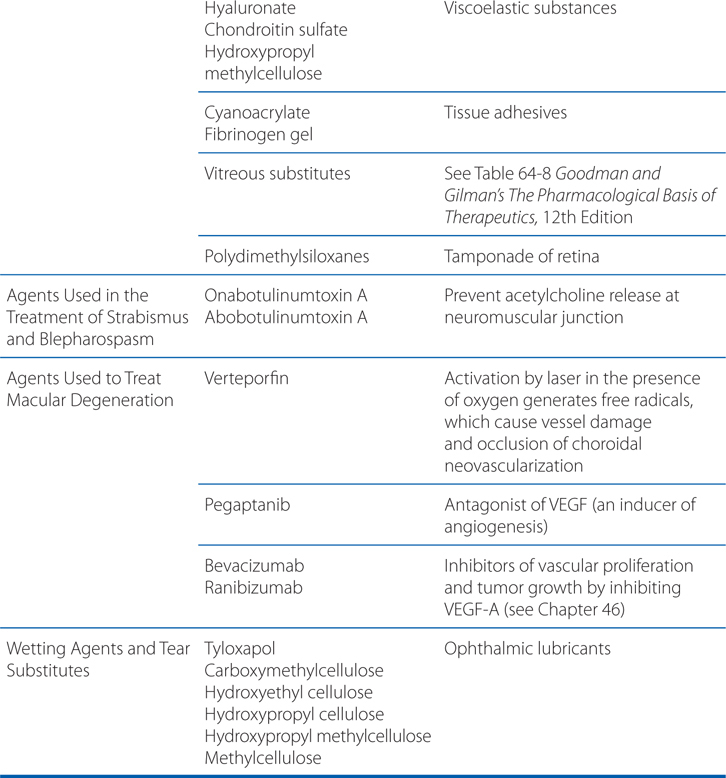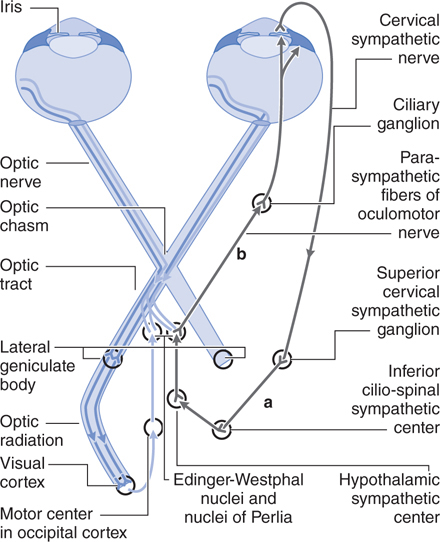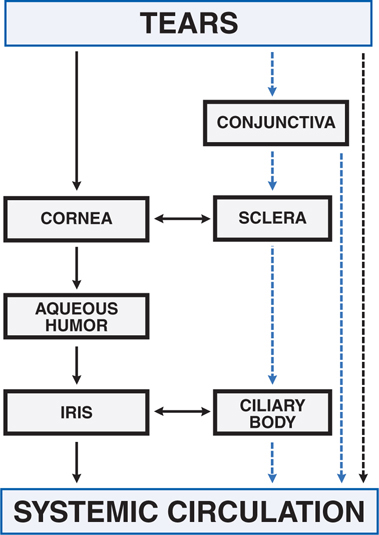47
Ocular Pharmacology
This chapter will be most useful after having a basic understanding of the material in Chapter 64, Ocular Pharmacology in Goodman & Gilman’s The Pharmacological Basis of Therapeutics, 12th Edition. In addition to the material presented here, the 12th Edition contains:
• A detailed description of the anatomy of the eye and extraocular structures
• Table 64-1 Autonomic Pharmacology of the Eye and Related Structures
• Table 64-8 Vitreous Substitutes
• The mechanism of action of vitamin A in retinal physiology and vision
• Figure 64-7 Structural formula for β-carotene and structural formulas for the vitamin A family of retinoids
• Table 64-9 Ophthalmic Effects of Selected Vitamin Deficiencies and Zinc Deficiency
• Figure 64-8 Major steps in photoreceptor signaling
LEARNING OBJECTIVES
 Understand the principles of using drugs to treat ophthalmic disorders.
Understand the principles of using drugs to treat ophthalmic disorders.
 Know the ocular toxicities of systemic drugs.
Know the ocular toxicities of systemic drugs.
 Know the mechanisms of action, clinical uses, and toxicities of ophthalmic drugs.
Know the mechanisms of action, clinical uses, and toxicities of ophthalmic drugs.
 Describe how ophthalmic drugs administered topically can cause systemic side effects.
Describe how ophthalmic drugs administered topically can cause systemic side effects.
 Understand the pathophysiology of glaucoma and the role of pharmacotherapy in its management.
Understand the pathophysiology of glaucoma and the role of pharmacotherapy in its management.
DRUGS INCLUDED IN THIS CHAPTERa
• Abobotulinumtoxin A (DYSPORT)
• Acetylcholine (MIOCHOL-E)
• Apraclonidine (IOPIDINE)
• Atropine (ATROPINE-CARE, ISOPTO ATROPINE)
• Azelastine (OPTIVAR)
• Bepotastine (BEPREVE)
• Betaxolol (BETOPTIC, others)
• Bevacizumab (AVASTIN)
• Bimatoprost (LUMIGAN, LATISSE)
• Brimonidine (ALPHAGAN, others)
• Brinzolamide (AZOPT)
• Bromfenac (XIBROM)
• Carbachol (MIOSTAT, ISOPTOCARBACHOL, others)
• Carteolol (OCCUPRES, others)
• Chondroitin sulfate (VISCOAT)
• Cromolyn sodium (CROLOM, others)
• Cyanoacrylate tissue adhesive (ISODENT, DERMABOND, HISTOACRYL)
• Cyclopentolate (CYCYLOGYL, others)
• Cyclosporin A (RESTASIS)
• Dexamethasone (DEXASOL, others)
• Diclofenac (VOLTAREN, others)
• Difluprednate (DUREZOL)
• Dipivefrin (PROPINE, others)
• Dorzolamide (TRUSOPT, others)
• Echothiophate (PHOSPHOLINE IODIDE)
• Emedastine difumarate (EMADINE)
• Epinastine (ELESTAT)
• Fibrinogen glue (TISSEEL, EVICEL)
• Fluocinolone ophthalmic implant (RETISERT)
• Fluorescein sodium
• Fluorometholone (FML, others)
• Fluorouracil
• Flurbiprofen (OCUFEN, others)
• Homatropine (ISOPTO HOMATROPINE, others)
• Hyaluronate (HEALON, others)
• Hydroxyamphetamine + topicamide (PAREMYD)
• Hydroxypropyl cellulose ophthalmic insert (LACRISERT)
• Hydroxypropylmethylcellulose
• Indocyanine green
• Ketorolac (ACULAR, others)
• Ketotifen fumarate (ZADITOR, ALAWAY)
• Latanoprost (XALATAN)
• Levobunolol (BETAGAN, others)
• Lodoxamide tromethamine (ALOMIDE)
• Loteprednol (ALREX, LOTEMAX)
• Metipranolol (OPTIPRANOLOL, others)
• Mitomycin (MUTAMYCIN)
• Naphazoline (AK-CON, ABALON, NAPHCON, others)
• Nedocromil (ALOCRIL)
• Nepafenac (NEVANAC)
• Olopatadine (PATANOL, PATADAY)
• Onabotulinumtoxin A (BOTOX)
• Pegaptanib (MACUGEN)
• Pemirolast (ALAMAST)
• Phenylephrine + cyclopentolate (CYCLOMYDRIL)
• Phenylephrine + scopolamine (MUROCOLL-2)
• Polydimethylsiloxanes (ADATOSIL 5000)
• Prednisolone (PRED FORTE, others)
• Povidone iodine (BETADINE OPHTHALMIC)
• Ranibizumab (LUCENTIS)
• Rimexolone (VEXOL)
• Scopolamine (ISOPTO HYOSCINE)
• Tetrahydrozoline (ALTAZINE, MURINE, VISINE, others)
• Timolol (TIMOPTIC, BETIMOL, others)
• Travoprost (TRAVATAN, TRAVATAN Z)
• Triamcinolone intravitreal formulations (TRIVARIS, TRIESENCE)
• Tropicamide (MYDRIACYL)
• Trypan Blue (VISIONBLUE, MEMBRANEBLUE)
• Tyloxapol (ENUCLENE)
• Verteporfin (VISUDYNE)
aDrugs included in this chapter have specific ophthalmic uses. Antimicrobial agents are listed in Tables 47-1 through 47-3. Their pharmacology is discussed in previous chapters.
TABLE 47-1 Topical Antibacterial Agents Commercially Available for Ophthalmic Use
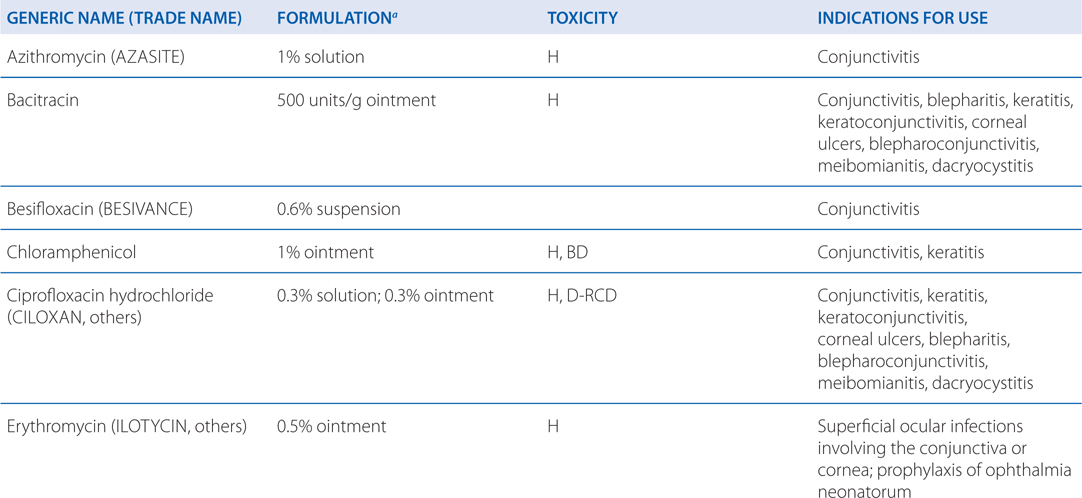
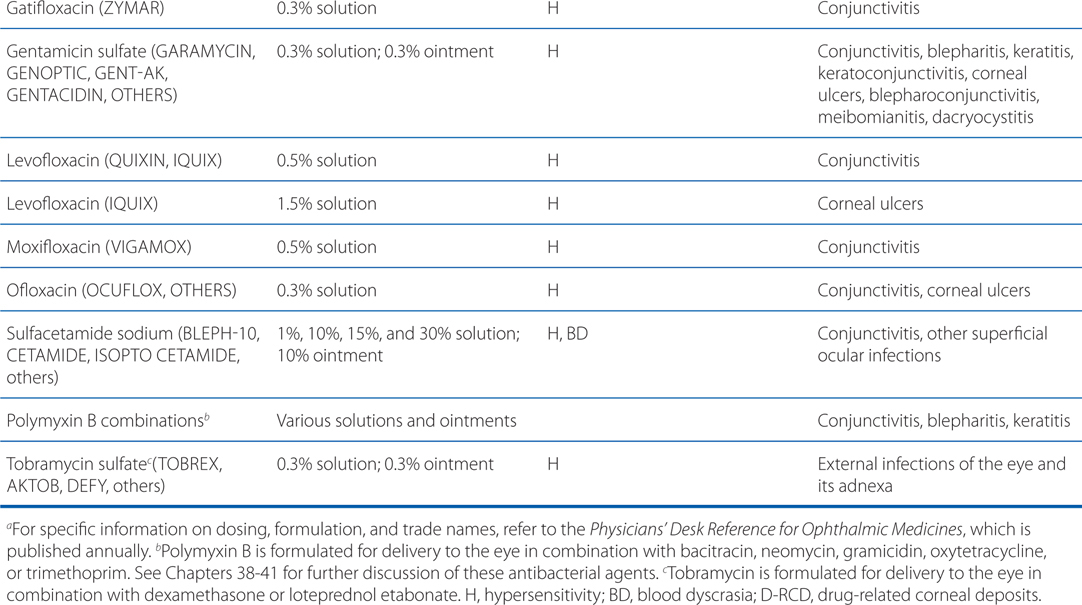
TABLE 47-2 Antiviral Agents for Ophthalmic Use

TABLE 47-3 Antifungal Agents for Ophthalmic Use
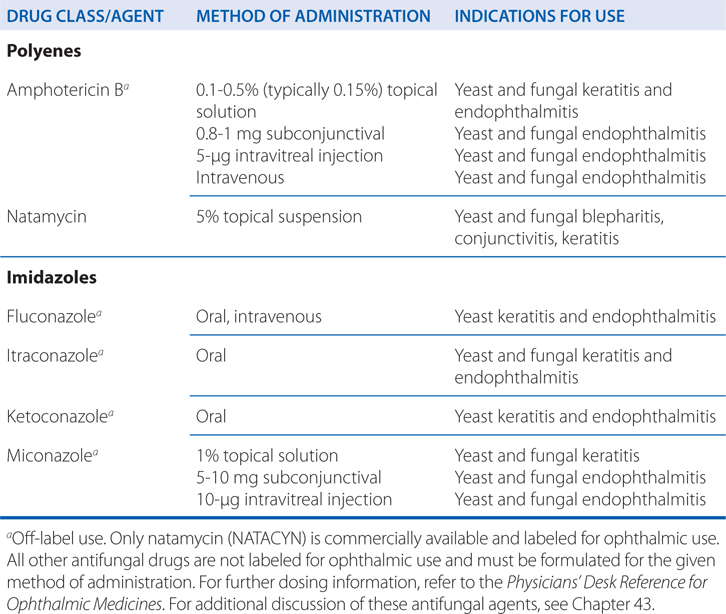
MECHANISMS OF ACTION OF DRUGS FOR OPHTHALMIC USE
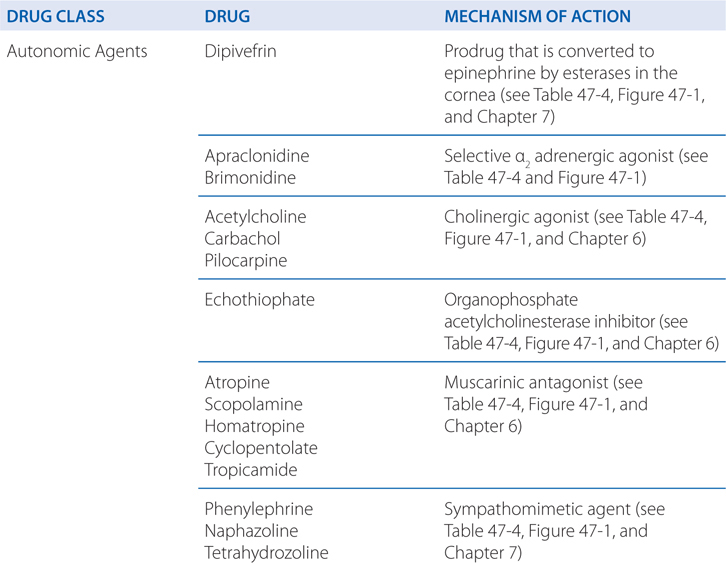
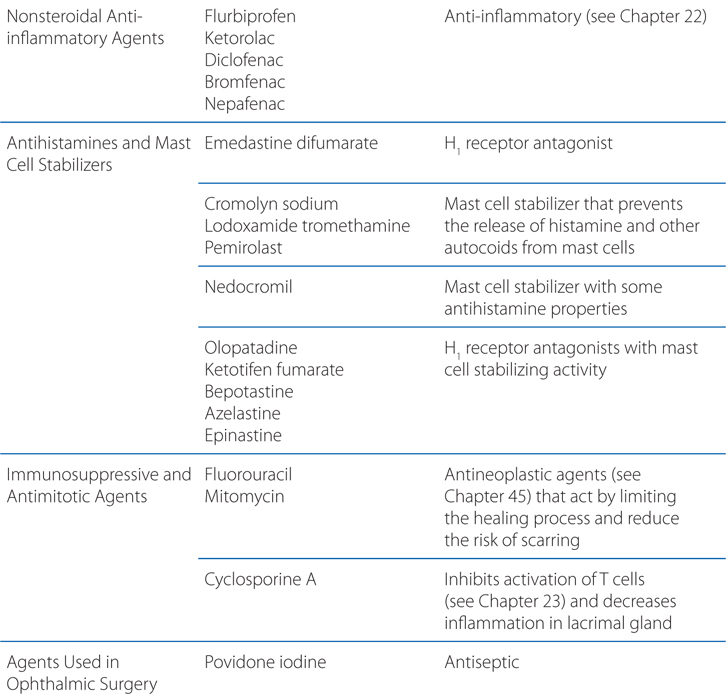
TABLE 47-4 Autonomic Drugs for Ophthalmic Use
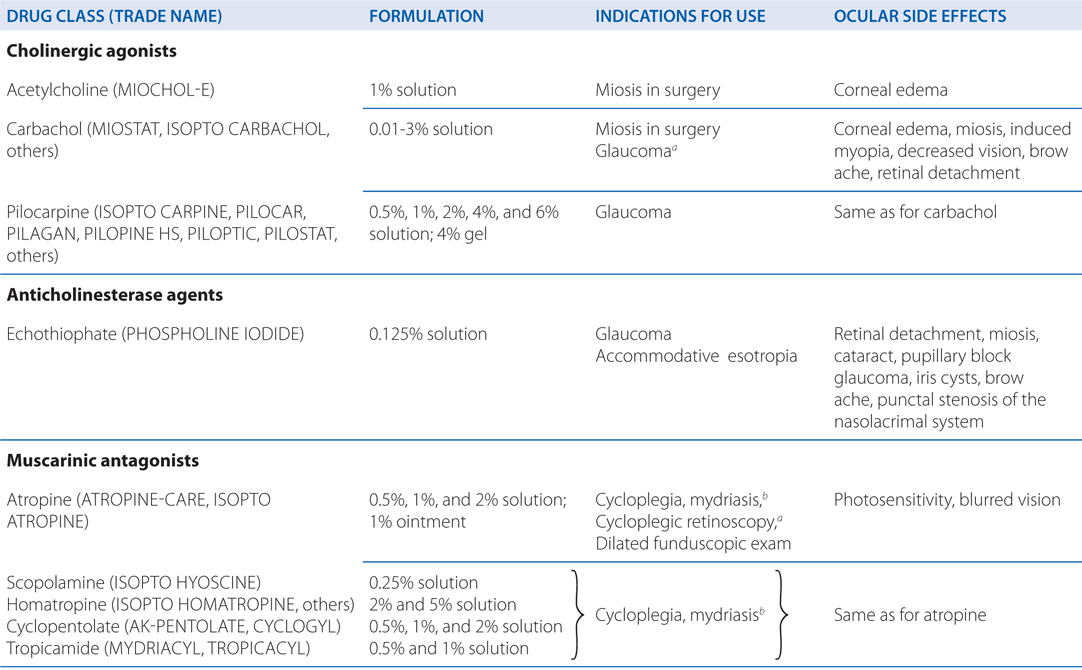
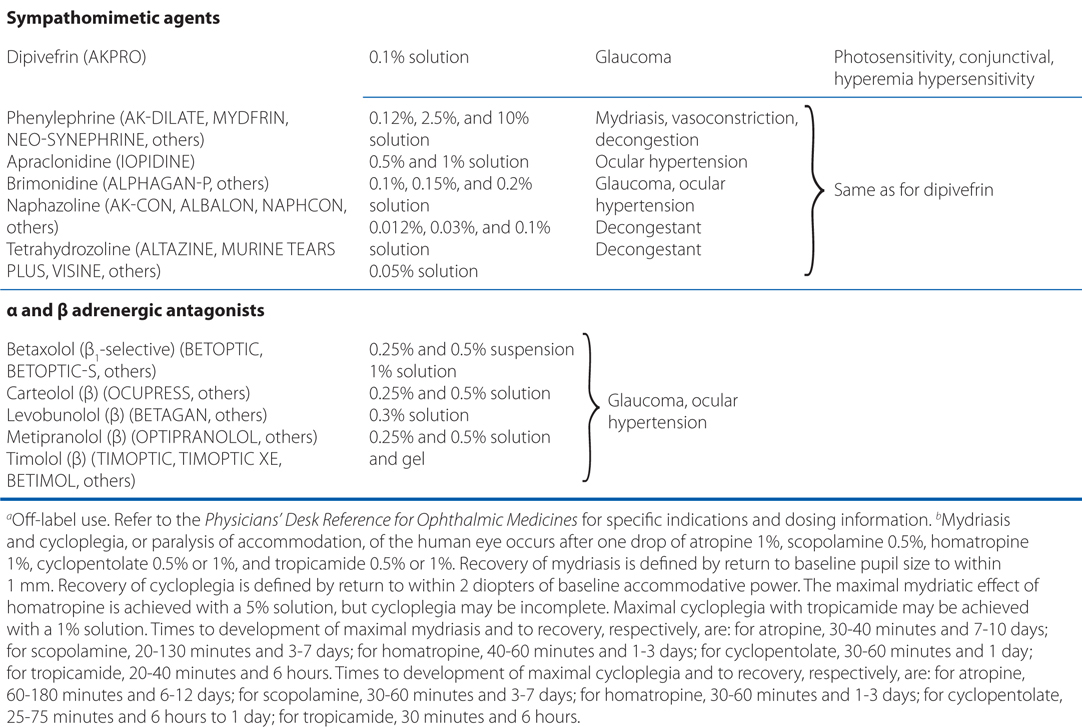
FIGURE 47-1 Autonomic innervation of the eye by the sympathetic (a) and parasympathetic (b) nervous systems. (Adapted with permission from Wybar KC, Kerr-Muir M. Baillière Concise Medical Textbooks, Ophthalmology, 3rd ed. Baillière Tindall, New York, 1984. Copyright © Elsevier.)
SYSTEMIC DRUGS WITH OCULAR SIDE EFFECTS

A 48-year-old man with a 10-year history of congestive heart failure following an acute myocardial infarction is treated with timolol eye drops for increased intraocular pressure (IOP). After using the eye drops for 1 week the patient notices increased fatigue and shortness of breath.
a. What kind of drug in timolol?
Timolol is a nonselective β adrenergic receptor antagonist (see Chapter 7). Its adverse systemic effects are bradycardia, negative cardiac inotropy, and decreased cardiac output. These effects would worsen this patient’s congestive heart failure.
b. How is the timolol associated with a worsening of this patient’s heart failure when the drug is being administered as drops to the eye?
All ophthalmic medications are potentially absorbed into the systemic circulation (see Figure 47-2; Table 47-5), so undesirable systemic side effects may occur. Topically administered drugs may undergo systemic distribution primarily by nasal mucosal absorption and possibly by local ocular distribution by transcorneal/transconjunctival absorption. Following transcorneal absorption, the aqueous humor accumulates the drug, which then is distributed to intraocular structures as well as potentially to the systemic circulation via the trabecular meshwork pathway (see Figures 47-2 and 47-3).
TABLE 47-5 Some Characteristics of Ocular Routes of Administration
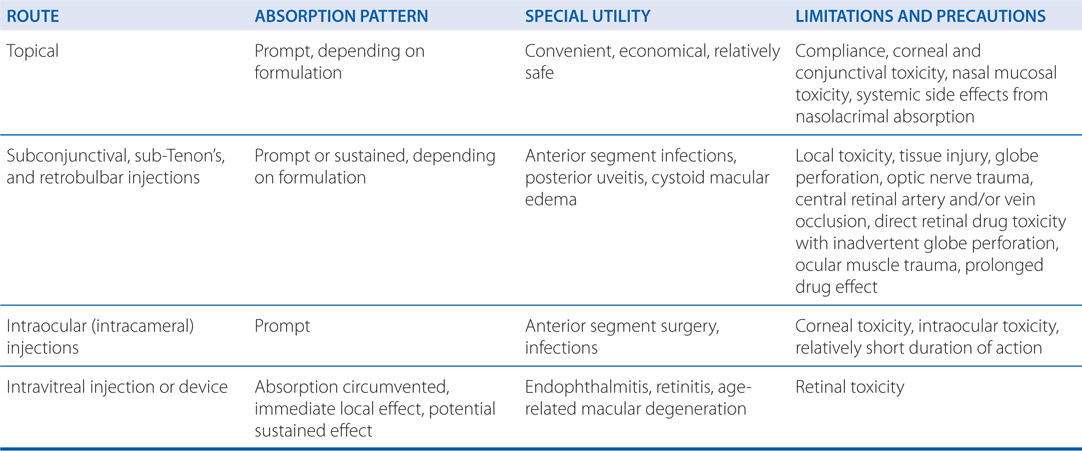
FIGURE 47-2 Possible absorption pathways of an ophthalmic drug following topical application to the eye. Solid black arrows represent the corneal route; dashed blue arrows represent the conjunctival/scleral route; the black dashed arrow represents the nasolacrimal absorption pathway. (Adapted with permission from Chien DS et al. Curr Eye Res. 1990;9:1051–1059. Copyright © Taylor & Francis Group, http://www.informaworld.com.)
Stay updated, free articles. Join our Telegram channel

Full access? Get Clinical Tree



